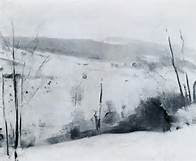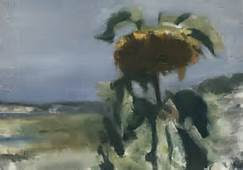Is it just laziness or is it just more honest to find the world
lacking than to imagine it fulfilling ones dreams. I follow on Twitter quotes
from “Moby Dick” that seem to reinforce the sense of the disconnect between
dream and reality, the ephemerality of things coming and going, appearing/disappearing.
A sailor on a calm day stationed on the mizzenmast loses balance and falls into
the sea never to be seen again. Or the crew of the Pequod losing all sense of
self-determination at the hands of Ahab: helping to fulfill Ahab’s dreams, whose
own utmost dream that they are embroiled in, is nonetheless left unfulfilled.
The strange interface between desire and reality is worth
meditating on. For the nexus to work it seems that one has to dumb down both
reality and desire. The reality of Facebook and Twitter probably encapsulate a
space where one can imagine a “like” to one’s opinion to be self-reaffirming.
I wonder as I read about the current political currency of Right
and Left and having to adjust my opinions based on the latest revelation of who
did what to whom or in the case of one candidate just forgot to do period, I
don’t know what is fact or fiction, everything seems to be mediated. Are the
Russians manipulating the news or is it Soros or the Koch brothers. Can I base
my self-worth on having opinions about something that may or may not be real? But
it is the tissue that ties me to the world. Do I exist without out it? According
to the political theorist Carl Schmitt an intellectual admired by the Right and
Left we are pure political animals hungering not so much to be for something as
in need of an enemy.
But there are some things that transcend this mediated reality.
Before reality’s waxing and waning, its sudden contretemps and pirouettes,
comes the personality of the observer and that personality has a history in its
ancestry. The mediation of reality comes from a historical predilection to
engage or not in the public realm. To know what I can control and what is
beyond my control. I am still startled to this day by a comment made in
conversation by an Armenian after the funeral of his brother in law, my good friend
William A. Henry 111, a journalist and author who died in his early forties. As
Armenians, he stated, we will always be outsiders. The principal of a large public school in Rhode Island, he
was as far as I could tell successful in his occupation. The details of what prompted the conversation
escape me as the conversation took place more than 20 years ago. I recall
relating it to my cousin who, like myself, is half Armenian. She is involved in
and founded several charities one directed toward Armenia, another purely directed toward
the US, which brings her in contact with the Country Western musicians who
perform at her fundraisers. No one would appear more integrated into American
culture than her. Yet she was in total agreement and seemed interested in
pursuing the topic later but probably as many years have gone by since that
conversation as have transpired since I spoke with the Armenian school
principal and we have not picked up where we left off. But that notion of
estrangement resonated within me and was a sort of confirmation of that
estrangement from the dominant culture that was continually reinforced by
anecdotes from family history: a sense, in short of an outsider looking in at
something at core alien to itself. Oddly
the most poignant one comes from my mother’s side of the family. They were
Germans living in the woods of NH and from stories my mother told harshly
discriminated against by the Yankee natives. It was assumed that as immigrants
they had no right to vote although they were in fact American citizens forcing my
grandmother at one point to go to the state capitol to get proof of their
citizenship. My father related numerous stories where he observed a sharp
line between his cultural upbringing and that of the Yankee aristocracy that
lived on the other end of Huron Ave in Cambridge.He enjoyed reminding me that even if they had more money than he did they did not know how to eat properly.
 |
The house's reincarnation in a "chic" neighborhood of Providence RI
Its name came from a Billy who lived there on the pond so as to distinguish him from a relative called Hillbilly |
In the recent film “Spotlight” portraying the expose by the “Boston
Globe” of the sexual predation by priests of the Catholic church on adolescents,
the lawyer an Armenian, pursuing the diocese on behalf of the victims could
have followed a path that let the Church deal on its own with its problems internally. As
an outsider and from a people who were persecuted by a hegemonic regime, he identified
with the victims of this horrific injustice. He felt compelled to bring the
perpetrators out from under the shelter of the church into the harsh light of
the criminal justice system. Was it a memory of how Armenians were treated by
the Turks in the Ottoman Empire that haunted him? Being a stranger in one's own
land was brilliantly portrayed in Elia Kazan’s “America America”. Kazan conveys
vividly how nothing could be done to right the injustices imposed by the
Ottoman Turks on the Armenians and Greeks, so absolute was the control they had on their ethnic
minorities, short of outright revolution. When the main character, an Anatolian
Greek, inadvertently gets involved in a conflict with the Turkish authorities on the side of a revolutionary
Armenian group, his father has to solicit the help of his contacts in the
government to get his son freed from prison. It is a kind of slavishness, which
was the only way to survive in an oppressive society. This acquiescence was
not the route pursued by the Armenian lawyer. As my Armenian grandmother said
to the foreign-born husband of a woman she had taken into her apartment to
protect her from his abuse:” This is America. Women are free!” The Catholic Church
despite many of its still liberating credos and tenets remained Medieval as an
institution in its top down control over its followers. It had been a touchstone
for Catholic immigrants themselves persecuted by the Protestant majority in
America but as it gained acceptance and power within the society as a whole it succumbed
to the exploitation of those it was supposed to serve.
 |
| Stavros and Hovanness in "America America" 1963 |
I remember being startled in a conversation with a Navajo at
a craft store in Arizona that indicated he felt that we were not standing on
the same cultural platform. The interlocutor
showed his disdain for me not in words but by ending our conversation, which
seemed to be going quite smoothly, rather abruptly. In so doing, he seemed to say
or so it seemed, that although we were both American citizens there was a
difference in our American experience. I am sure it was nothing in particular
that I said but a feeling that he was sharing too much with me as an outsider about
his life. Would it be any different if I were chatting with a Turk about both
coming from Anatolia until we realized that the experience of my ancestors at
the hands of his ancestors was nothing he wanted to acknowledge. And most
likely he would have been indoctrinated to see me as an age-old archenemy.
I had a friend of pure WASP ancestry, descended from a world
of country clubs, tennis whites and a notion of where to live and how to properly
behave in society (a domain where I was always falling short to his chagrin). Whenever
the stock market would collapse, he would admonish me to invest in Phillip
Morris. He confessed that this was the stock of preference of the aristocracy.
If you look at this chart you will see it has almost doubled since 2014 and even now offers a dividend yield close to 4%. In this yield
starved economy where the pensioner, who put his money in treasuries is getting
close to zero percent this is extraordinary. Why bother with hot tech stocks
when you can invest in the exploration of new markets for nicotine in the Third World. Of course I never took his advice because it was hard for me to
understand that some things are absolutely true and incontrovertible. For me reality
is only in the end doom and gloom and genocide. But if there are enough people
with money out there to say something is safe it is naïve to think otherwise.

It is also naive to think we all judge others from some
universal point of view. Nietzsche talked about the creation of human types
over millennia. Max Weber felt that Capitalism was the outcome of the Protestant
work ethic and Melville sees it at work in the Quaker Ahab for whom the
metaphysics of good and evil underlie his capitalist quest to such a
degree so as to usurp the tallying of good and evil solely in terms of money.
And now I understand that country club membership and the facades of beautiful
homes in enclaves like Annisquam, Massachusetts ,where reality and desire meet, are
paid for from dividends from Phillip Morris.















